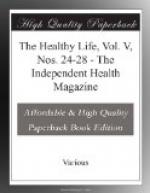In meat the waste in preparation and consecutive waste at table is considerable. To really introduce 200 grammes of meat into the stomach, nearly 400 grammes must be purchased, and expensively put into use. What do these 200 grammes really bring in nutritive elements?
Meat.
200 gr. (mod. fat.) at 18% albumin
= 36 gr. album., about.
" " 5% fat = 10 gr. fat,
about.
-----
46 gr.
These 46 grs. constitute barely the
8 per cent. of the total weight of
a ration, averaged in nutritive elements, calculated
as follows:—
Albumin 80 Fatty matters 70 Hydrates of carbon 350
This is a very feeble proportion.
If one turns to the calorific point of view, in order to estimate the share of energy useful to the organism, we arrive at much the same conclusion. The 46 grs. of nutritive animal elements barely provide 230 thermal units which can be utilised, while the total diet which we are considering brings a power of disposal of nearly 2,350 thermal units. It is, even then, barely 10 per cent. of the total energy. The most convinced flesh eaters, those who buy 400 grs. of meat a day for their consumption, must learn, willingly or unwillingly, that the animal element enters only in an infinitesimal part into their real substance and reparation.
VIII
Beyond this very feeble nutritive help is there, then, in meat, anything else which makes the use of this article of food necessary, agreeable or particularly strengthening? It is incontestible that meat contains stimulating substances, which, as Prof. Armand Gautier has said, play the part of nerve tonics, and have perhaps a direct action on the circulation.
These special meat matters are found concentrated in the gravy. Meat gravy, in fact, beside a feeble proportion of albuminoid matters, or solubly derived quantities, polypeptides, etc., in notable proportion of liberated acids, contains a certain quantity of matters, qualified by the generic name of extractives; a notable quantity of these extractive matters being creatine and creatinine, as well as substances of which the fundamental nucleus is the puric grouping. These purins, by the name which E. Fischer attributes to them, derive from a special grouping which it would be supposed exists in a hypothetic body, but which is not known in a state of liberty, purin. This first term gives rise to a series of bodies in lateral groups, of which the most interesting are caffeine and theobromine. Amongst these substances the one which has the maximum of oxidation is no other than uric acid. Caffeine and theobromine enjoy nervine properties and energetic vascular actions. These properties minutely studied are utilised every day for therapeutic purposes. It is probable that the other bodies of the series which are met with in the extract of meat enjoy analogous physiological




